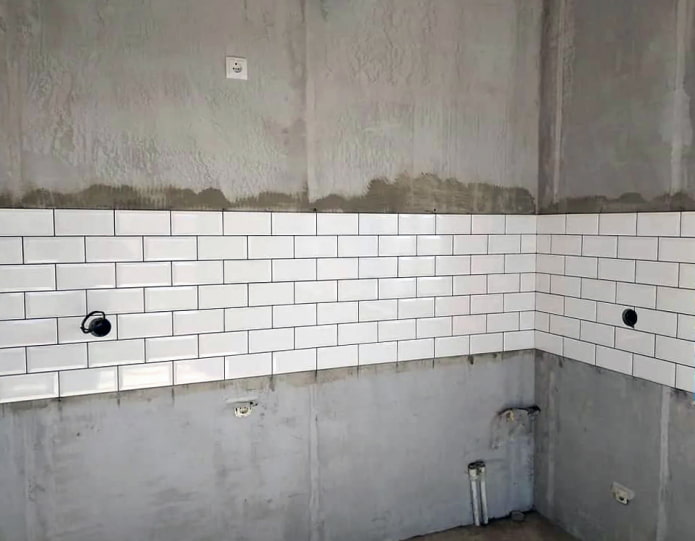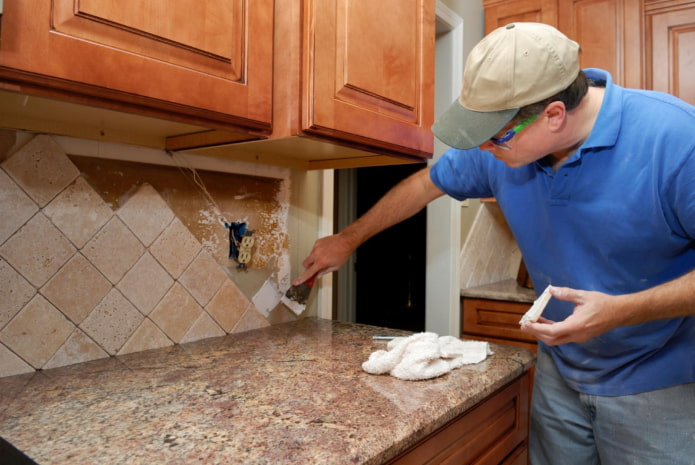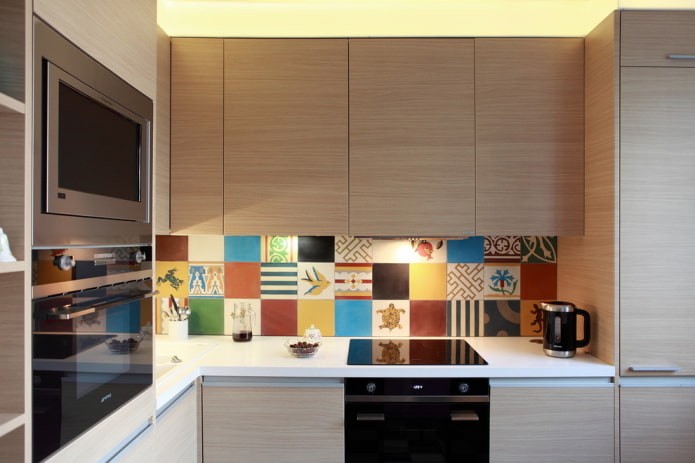First, the apron
This option seems easier to implement, especially if you are not demanding about the aesthetics of the kitchen. First, lay the ceramic tiles with a margin, then install the lower cabinets, and then hang the upper cabinets.
Pros:
- The main advantage of this method is that less time will be spent on repairs. Installation will be completed faster, and you will save yourself from unnecessary cleaning – the set will fit into a fully finished kitchen and you will not have to wash it from tile adhesive.
- A significant plus is saving money. Careful adjustment of the apron to the dimensions of the furniture and tiles requires highly qualified kitchen set designer and workers. In the case where the tiles are laid independently and the furniture is assembled manually, it is more convenient and cheaper to first tile the cooking area.
This option also has its disadvantages:
- The furniture will not be adjacent to the wall, it will stand close to the tiles. This threatens gaps where dirt and water will get in, especially if the walls or floor are not perfectly leveled.
- The gap will have to be covered with a corner or a side, which rarely looks attractive.
- The tiles are laid with a margin, which means you will need to buy more material.
- There is a risk of overlapping the pattern on the apron, as well as missing the seam and “cutting” the whole element in half. The problem is partially solved by adjusting the height of the furniture using legs.
If the apron is glass, this sequence is unacceptable: its installation is performed only after the complete installation of kitchen furniture and built-in appliances.

First the kitchen set
In this case, the furniture is installed first, and then the apron is laid. Professionals prefer this method, since it is easier to match the apron to the kitchen than vice versa.
Pros:
- The kitchen looks like a single whole, it looks more elegant and expensive.
- The pattern on the tile is not cut off, and the lower and upper modules of the set are tightly adjacent to the apron.
- The cabinets can be pushed against the wall and do without a sealing plinth between the countertop and the apron: there will simply be no gaps.
Cons:
- The work takes more time.
- Laying the apron requires professional workers, which is difficult to predict.
- You will have to install the tiles as carefully as possible: protect the facades from chips and dents, and the countertop from dirt. Any damage to the tile itself will be more noticeable, so you should cut it more carefully.
- Facing the apron is complicated by the lower cabinets standing “in the way”.

Conclusions
If you want to save money and aesthetics are not your top priority, lay the tiles first and then install the furniture. In this case, it is difficult to fit the elements together, but it is doable – proper measurements work wonders.
If you want the perfect kitchen, first install the furniture and then lay the tiles. The method is also effective if there are uneven walls: the surface can be leveled using tile adhesive.

Both methods have a right to exist – choose the most suitable one for yourself.
Now reading:
- 12 Creative Solutions for Zoning a Compact Studio
- World Map in Interior Design: Characteristics and Examples of Images
- Bedroom without a window: 35 eye-catching images and useful tips.
- 60 ideas and inspiring photos of white kitchen interiors with wood countertops
- Effective Ways to Hide Your Bed in Your Room